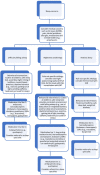A multidisciplinary approach and consensus statement to establish standards of care for Angelman syndrome
- PMID: 35150089
- PMCID: PMC8922964
- DOI: 10.1002/mgg3.1843
A multidisciplinary approach and consensus statement to establish standards of care for Angelman syndrome
Abstract
Background: Angelman syndrome (AS) is a rare neurogenetic disorder present in approximately 1/12,000 individuals and characterized by developmental delay, cognitive impairment, motor dysfunction, seizures, gastrointestinal concerns, and abnormal electroencephalographic background. AS is caused by absent expression of the paternally imprinted gene UBE3A in the central nervous system. Disparities in the management of AS are a major problem in preparing for precision therapies and occur even in patients with access to experts and recognized clinics. AS patients receive care based on collective provider experience due to limited evidence-based literature. We present a consensus statement and comprehensive literature review that proposes a standard of care practices for the management of AS at a critical time when therapeutics to alter the natural history of the disease are on the horizon.
Methods: We compiled the key recognized clinical features of AS based on consensus from a team of specialists managing patients with AS. Working groups were established to address each focus area with committees comprised of providers who manage >5 individuals. Committees developed management guidelines for their area of expertise. These were compiled into a final document to provide a framework for standardizing management. Evidence from the medical literature was also comprehensively reviewed.
Results: Areas covered by working groups in the consensus document include genetics, developmental medicine, psychology, general health concerns, neurology (including movement disorders), sleep, psychiatry, orthopedics, ophthalmology, communication, early intervention and therapies, and caregiver health. Working groups created frameworks, including flowcharts and tables, to help with quick access for providers. Data from the literature were incorporated to ensure providers had review of experiential versus evidence-based care guidelines.
Conclusion: Standards of care in the management of AS are keys to ensure optimal care at a critical time when new disease-modifying therapies are emerging. This document is a framework for providers of all familiarity levels.
Keywords: Angelman Syndrome; UBE3A; genetics; management; neurogenetics.
© 2021 The Authors. Molecular Genetics & Genomic Medicine published by Wiley Periodicals LLC.
Figures




References
-
- Adams, D. , Clarke, S. , Griffith, G. , Howlin, P. , Moss, J. , Petty, J. , Tunnicliffe, P. , & Oliver, C. (2018). Mental health and well‐being in mothers of children with rare genetic syndromes showing chronic challenging behavior: A cross‐sectional and longitudinal study. Am J Intellect Dev Disabil, 123(3), 241–253. 10.1352/1944-7558-123.3.241. - DOI - PubMed
Publication types
MeSH terms
Grants and funding
LinkOut - more resources
Full Text Sources
Research Materials

